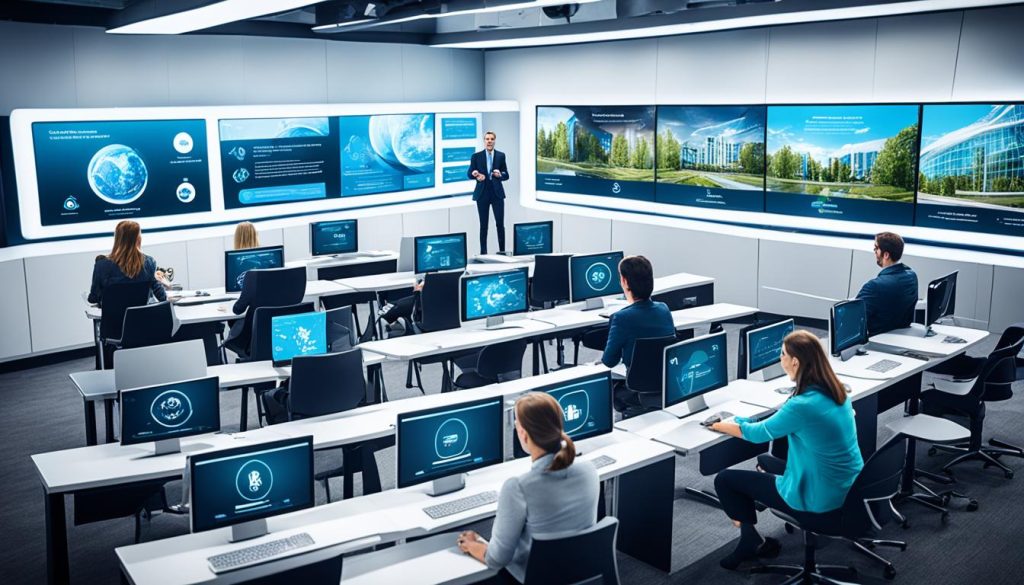Corporate e-learning platforms have revolutionized professional development in today’s rapidly changing business landscape. These platforms offer a comprehensive solution for organizations to nurture the skills of their workforce, ensuring they stay competitive and up-to-date with industry trends.
Investing in corporate e-learning platforms such as enterprise e-learning solutions, e-learning platforms for corporations, and corporate training platforms has become a crucial strategic move for organizations looking to empower their employees. These platforms provide continuous training opportunities, enabling employees to acquire new skills, explore fresh perspectives, and embrace challenges in their professional journey.
In this article, we will explore how corporate e-learning platforms empower organizations and contribute to their overall success. We will delve into the changing dynamics of the workplace, the importance of fostering a culture of continuous learning, addressing skills gaps, adopting technological solutions, and encouraging professional growth.
Through this comprehensive exploration, organizations will gain valuable insights into the pivotal role corporate e-learning platforms play in shaping a skilled workforce capable of driving innovation and achieving organizational goals.
Key Takeaways:
- Corporate e-learning platforms empower organizations by providing continuous training and development opportunities for their workforce.
- These platforms foster a culture of continuous learning, address skills gaps, and enhance employee engagement and retention.
- The dynamics of the workplace are constantly changing, and organizations need to adapt by providing continuous learning opportunities.
- Fostering a culture of continuous learning encourages employees to acquire new skills, explore fresh perspectives, and embrace challenges as opportunities for growth.
- Corporate e-learning platforms help organizations address skills gaps that may arise due to changes in industry trends or technological advancements.
The Changing Dynamics Of The Workplace
The dynamics of the workplace are constantly evolving to keep pace with advancements in technology, shifts in consumer behavior, and the globalization of business. In this rapidly changing landscape, organizations must adapt their strategies to create a thriving work environment. One crucial aspect of this adaptation is providing continuous learning opportunities for employees.
Continuous learning plays a vital role in helping employees stay updated with industry trends and acquire new skills. By embracing a culture of continuous learning, organizations empower their workforce to navigate the dynamic workplace with confidence and agility.
Advancements in technology have transformed the way we work and have revolutionized various industries. From automation to artificial intelligence, employees need to stay abreast of these advancements to remain competitive. Continuous learning equips employees with the knowledge and skills needed to leverage these technological advancements and drive innovation within their organizations.
Furthermore, shifts in consumer behavior have reshaped business models and strategies. To meet the evolving needs and preferences of customers, organizations must understand these shifts and adapt their approaches accordingly. Continuous learning enables employees to understand and respond to changing consumer behaviors, ensuring that their organizations remain relevant and competitive in the market.
Globalization has opened up new avenues for business growth and collaboration. However, it has also increased competition and created a need for cross-cultural understanding. Continuous learning helps employees develop the necessary skills to thrive in a globalized business landscape, such as cultural intelligence and effective communication across borders.
“Continuous learning equips employees with the knowledge and skills needed to navigate the changing dynamics of the modern workplace and contribute to organizational success.”
By investing in continuous learning initiatives, organizations not only equip their employees with the skills needed for current roles but also future-proof their workforce. A workforce that embraces continuous learning becomes adaptable, resilient, and better prepared to embrace new challenges and opportunities as they arise.
Impact of Continuous Learning on Workplace Dynamics
| Benefits | Examples |
|---|---|
| Enhanced Employee Engagement | Increased productivity, higher job satisfaction |
| Improved Organizational Agility | Ability to respond quickly to market changes |
| Increased Innovation | New ideas and solutions generated by employees |
| Enhanced Employee Retention | Reduced turnover and increased loyalty |
Continuous learning is essential in fostering a high-performance culture and driving organizational success. It empowers employees to adapt, innovate, and thrive in the dynamic workplace, ensuring that organizations remain competitive in an ever-changing business landscape.
Fostering A Culture Of Continuous Learning
Fostering a culture of continuous learning is crucial for organizations to empower their employees. By creating an environment that values learning as an ongoing process, organizations can encourage employees to acquire new skills, explore fresh perspectives, and embrace challenges as opportunities for growth. This cultural shift sets the stage for the implementation of effective training programs that cater to the evolving needs of both the employees and the organization.
At XYZ Company, we believe in cultivating a culture of continuous learning that fosters personal and professional growth. We understand that in today’s fast-paced and ever-changing business landscape, it is essential for our employees to stay ahead of the curve. By embracing a culture of learning, we encourage our employees to take ownership of their development, acquire new skills, and push the boundaries of their capabilities.
Continuous learning enables employees to broaden their knowledge base, adapt to changing market trends, and explore innovative solutions. It creates an environment where employees are motivated to seek out new challenges and proactively acquire the skills needed to thrive in their roles.
By encouraging employees to embrace challenges and explore fresh perspectives, organizations can tap into their full potential, fostering a workforce that is agile, adaptable, and innovative.
This commitment to continuous learning not only benefits individual employees but also sets the foundation for organizational success. Organizations that prioritize a culture of learning are better equipped to navigate industry disruptions, embrace technological advancements, and drive innovation. It creates a mindset of continuous improvement where employees are constantly seeking ways to enhance their skills, knowledge, and performance.
Implementing Effective Training Programs
Implementing effective training programs is a vital component of fostering a culture of continuous learning. These programs should be designed to address the specific needs and goals of employees, providing them with the tools and resources required for growth.
Training programs can take various forms, such as workshops, seminars, online courses, and mentoring programs. By offering diverse learning opportunities, organizations cater to different learning styles and ensure that employees have access to the knowledge and skills necessary for success.
At XYZ Company, we provide our employees with a comprehensive range of training programs that cover a wide array of topics. From technical skills development to leadership and communication training, we invest in our employees’ professional growth and encourage them to acquire new skills relevant to their roles and aspirations.
Creating a Supportive Learning Environment
Creating a supportive learning environment is essential for fostering a culture of continuous learning. This involves providing employees with the necessary resources, support, and encouragement to pursue their learning objectives.
At XYZ Company, we offer dedicated learning and development teams that work collaboratively with employees to identify their learning needs and design personalized development plans. We also provide access to various online platforms and tools that allow employees to explore new concepts and acquire knowledge at their own pace.
Moreover, we recognize and celebrate employees’ achievements and milestones in their learning journey. This recognition not only motivates employees but also reinforces the value placed on continuous learning within the organization.
To foster a culture of continuous learning, it is crucial for organizations to create an environment where employees are encouraged to acquire new skills, explore fresh perspectives, and embrace challenges. By embracing this culture, organizations empower their employees to stay ahead in a rapidly changing world, drive innovation, and propel the organization towards future success.

Addressing Skills Gaps
Continuous training and development initiatives are instrumental in addressing skills gaps that may emerge due to changes in industry trends or technological advancements. Organizations must adapt to the evolving landscape by equipping their employees with the necessary skills to thrive in the modern workplace.
Regular assessment of the skills required for various roles is key to developing effective training programs that meet the specific needs of employees. By identifying and addressing skills gaps, organizations can enhance the individual capabilities of their workforce and fortify their overall competitiveness in the market.
For instance, the rapid advancement of technology in industries such as IT and finance has created a demand for specialized skills. Organizations must proactively offer training programs to bridge the gap between existing knowledge and emerging requirements. By providing employees with opportunities to develop the required skills, organizations can maintain their relevance in the ever-changing landscape.
“Addressing skills gaps is not just about staying up to date with the latest industry trends. It’s about future-proofing your organization and empowering your employees to excel in their roles.”
– Alex Larson, HR Manager at Tech Synergy
Addressing skills gaps goes beyond immediate capacity building. It involves fostering a culture of continuous learning and personal development. Organizations that prioritize ongoing training and development initiatives create an environment where employees are encouraged to proactively seek out opportunities to acquire new skills and stay ahead of industry trends.
Case Study: Company X’s Training Program
Company X, a leading software development firm, recognized the importance of addressing skills gaps in an industry driven by technological advancements. They conducted a comprehensive skills assessment to identify areas where employees lacked expertise.
Based on the assessment results, Company X developed targeted training programs designed to equip employees with the required skills. These programs included classroom training, online courses, and hands-on workshops tailored to address specific skills gaps.
The impact of Company X’s training program was significant, with employees reporting increased confidence and improved job performance. The organization experienced enhanced productivity and competitiveness as employees upskilled and embraced new technological advancements.
The Importance of Training Programs
“Training programs are vital for addressing skills gaps and equipping employees with the relevant knowledge and skills they need to succeed. These programs enable organizations to adapt to changing industry trends and technological advancements, ensuring their workforce remains capable and competitive.”
– Emily Collins, Learning and Development Director at Success Solutions
Training programs play a crucial role in bridging skills gaps. They provide employees with the necessary tools and resources to stay updated with industry trends and technological advancements. These programs not only enhance individual capabilities but also contribute to the overall growth and success of organizations.
Moreover, training programs foster a learning culture within organizations. They encourage employees to actively engage in continuous learning and seek opportunities for professional development. This, in turn, leads to increased employee satisfaction, higher retention rates, and a workforce that is adaptable to changes.
Investing in training programs allows organizations to proactively address skills gaps, ensuring that employees are equipped with the knowledge and skills required to thrive in the ever-evolving workplace.
| Benefits of Training Programs | Effective Training Strategies |
|---|---|
|
|

Adopting Technological Solutions
In the digital age, technology plays a vital role in employee training and development. Organizations can leverage innovative tools and platforms to enhance the learning experience and stay ahead of the curve. Let’s explore some of the key technological solutions that are transforming corporate training.
eLearning Platforms: Unlocking Learning Potential
eLearning platforms have revolutionized the way employees engage with training materials. These platforms offer a wide range of courses and resources that employees can access at their convenience. The flexibility of eLearning platforms allows employees to learn at their own pace, making it ideal for personalized learning experiences. By utilizing these platforms, organizations can provide a diverse and comprehensive learning environment for their workforce.
Virtual Simulations: Bridging the Gap between Theory and Practice
Virtual simulations provide a realistic and immersive learning experience for employees. Through interactive scenarios and real-world simulations, employees can apply their knowledge and skills in a safe environment. This hands-on approach enhances learning outcomes by bridging the gap between theory and practice. Virtual simulations offer a practical way to build practical skills and improve decision making.
Mobile Applications: Learning on the Go
Mobile applications have transformed the way we access information, and employee training is no exception. With the ubiquity of smartphones and tablets, organizations can provide employees with learning opportunities on the go. Mobile applications enable bite-sized learning, allowing employees to fit learning into their busy schedules. Whether it’s a quick quiz or a short video, mobile applications make learning more accessible and convenient.

Personalized Learning Experience: Tailored to Individual Needs
One-size-fits-all training programs may no longer be effective in meeting the diverse needs and preferences of employees. Personalized learning experiences offer a solution by tailoring training content to individual learners. By utilizing data analytics and user feedback, organizations can create customized learning paths for employees. This approach maximizes engagement and ensures that employees acquire the specific skills and knowledge they need to excel in their roles.
Artificial Intelligence and Data Analytics: Enhancing Learning Effectiveness
The integration of Artificial Intelligence (AI) and data analytics in employee training has revolutionized learning effectiveness. AI-powered algorithms can analyze employee progress, identify knowledge gaps, and recommend personalized learning resources. Data analytics provide valuable insights into the effectiveness of training programs, enabling organizations to refine and improve their initiatives. By leveraging AI and data analytics, organizations can make data-driven decisions that optimize learning outcomes.
By adopting these technological solutions, organizations can create a dynamic and engaging learning environment for their employees. The combination of eLearning platforms, virtual simulations, mobile applications, personalized learning experiences, Artificial Intelligence, and data analytics empowers employees to develop the skills they need to succeed in a rapidly evolving business landscape.
Encouraging Professional Growth
Empowering employees through continuous training extends beyond acquiring job-specific skills. It encompasses the holistic professional development of individuals, enabling them to thrive in a rapidly evolving professional landscape. To this end, organizations can adopt various strategies to encourage and support the professional growth of their workforce.
Nurturing a Culture of Lifelong Learning
Inspiring a culture of continuous learning is critical for fostering professional growth. By providing opportunities for professional development, organizations empower employees to expand their knowledge and skills. This can be achieved through **certifications** that validate expertise in specific domains, workshops that facilitate hands-on learning experiences, and conferences that offer insights into industry practices and emerging trends.
“Investing in professional development equips employees with the tools they need to succeed and adapt in a rapidly changing business landscape.”
Collaborating with Industry Experts
Collaborating with industry experts can be a powerful driver of professional growth. Organizations can invite subject matter experts to conduct **workshops** or deliver insightful presentations, providing employees with valuable mentorship and exposure to cutting-edge industry knowledge. This collaborative approach not only enhances skillsets but also encourages networking and exchange of ideas among professionals.
Creating a Versatile Workforce
A versatile workforce is a strategic asset for organizations seeking long-term success. By empowering employees to engage in professional development initiatives, organizations nurture a **versatile workforce** capable of tackling new challenges and adapting to evolving industry demands. This can be achieved by offering learning paths tailored to individual career aspirations and providing the necessary resources for continuous growth.
Embracing Industry Best Practices
Embracing **industry best practices** is essential for professional growth. Organizations can cultivate a culture of excellence by encouraging employees to stay updated on the latest industry developments, trends, and techniques. This can be achieved through participation in conferences, industry forums, and online communities where employees can learn from peers, share experiences, and gain insights into emerging practices.

Investing in professional development not only enhances individual skills and knowledge but also contributes to the overall success of organizations. By encouraging employees to embrace continuous learning opportunities, organizations nurture a dynamic and adaptable workforce that can navigate the challenges of the ever-changing professional landscape.
Conclusion
Continuous training and development plays a vital role in the success of organizations in today’s dynamic workplace. By prioritizing the ongoing growth of their workforce, organizations position themselves to stay ahead of industry trends, foster innovation, and cultivate a culture of continuous improvement. In the face of technology-driven changes and evolving job roles, the commitment to empowering employees through continuous learning remains a cornerstone for organizational success.
Investing in continuous training and development not only enhances the skills and knowledge of employees but also boosts their engagement and satisfaction. By providing opportunities for learning and growth, organizations create a dynamic workplace where employees can thrive and contribute to the company’s success.
Furthermore, the benefits of continuous training and development extend beyond individual employees. Organizations that invest in their workforce’s ongoing development also increase their overall competitiveness in the market. A well-trained and adaptable workforce drives innovation, improves productivity, and ensures the organization can navigate the ever-changing business landscape effectively.
In conclusion, continuous training and development are essential for organizational success in today’s dynamic workplace. By prioritizing the growth of their workforce and fostering a culture of continuous learning, organizations can position themselves as leaders in their industry and create a thriving workplace where employees can excel.




No comments! Be the first commenter?